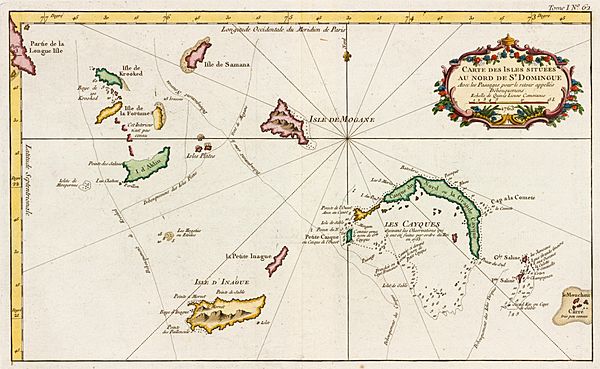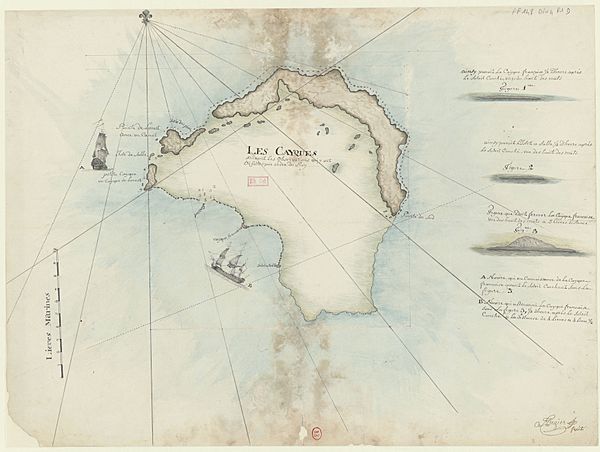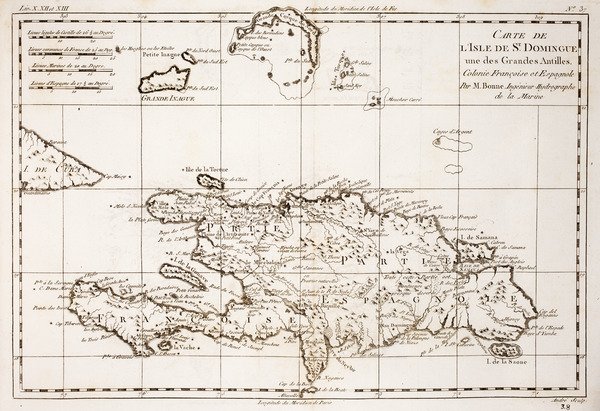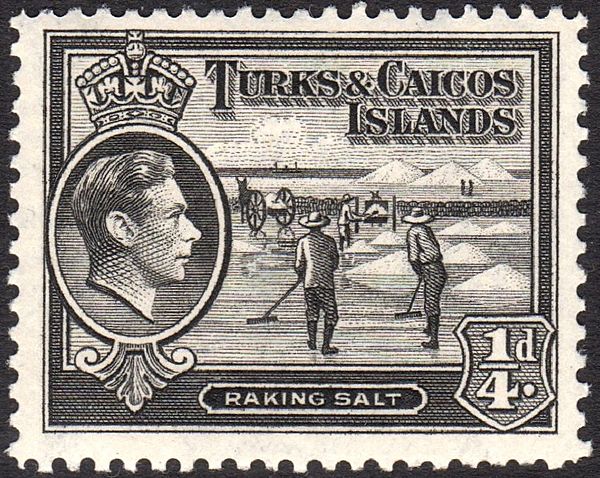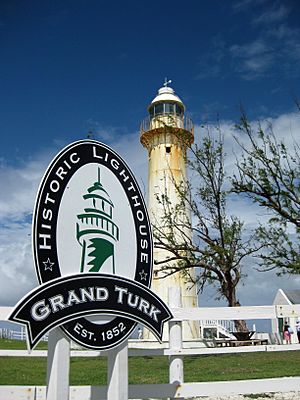History of the Turks and Caicos Islands facts for kids
The Turks and Caicos Islands were first home to the Taíno and Lucayan peoples. Europeans first saw these islands in 1512. Over the years, different European countries claimed the islands. But the British Empire eventually took control.
For a long time, the islands were ruled by other British colonies. These included Bermuda, the Bahamas, and Jamaica. In 1973, the Bahamas became independent. Then, the Turks and Caicos Islands got their own governor. They have been a separate British Overseas Territory ever since.
In 2009, the United Kingdom temporarily took over the islands' government. This happened because of concerns about how some officials were managing things. But self-rule was given back after elections in November 2012.
Contents
Early History of the Islands
Long before Christopher Columbus arrived in 1492, the Taíno and Lucayan peoples lived on the Turks and Caicos Islands. They were the first people to settle here. These early settlers were skilled at sailing, farming, and collecting salt. Many words we use today come from their Arawak language. For example, "canoe" and "Caribbean."
Even the name of the country comes from these first people. "Turks" refers to a local plant called the Turk's head cactus. "Caicos" comes from the Lucayan words "caya hico," meaning "string of islands."
For nearly 700 years, the Taíno and Lucayans were the only residents. They mostly lived on Middle Caicos and Grand Turk. They lived peacefully and were good at farming and fishing. They grew almost 50 types of plants. Some of these plants can still be found on the islands today.
These early people also loved shellfish, especially conch. Today, there is a special farm called the Caicos Conch Farm. It is the only commercial conch farm in the world. This farm helps make sure there are always enough conch.
European Arrival and Early Claims
After Columbus arrived in 1492, the Lucayan people disappeared. The islands were mostly empty for about 30 years. During this time, the salt-making business began. People from Bermuda came to the Turks and Caicos to collect salt. Salt was very important back then. It was used to keep food from spoiling.
The shallow waters around the islands were great for collecting salt. But they were also dangerous for ships. More than 1000 ships were wrecked trying to get to and from the islands.
The first time Europeans officially saw the islands was in 1512. For the next few centuries, Spain, France, and England (later Britain) all claimed the islands. But none of them built any lasting settlements.
Around 1709, an early British settler named Bernard Caicos arrived. His last name and stories about his family's background gave the islands their current name.
From about 1690 to 1720, pirates used the small islands, called cays, as hiding spots. They would attack Spanish ships carrying treasure. These ships were sailing from places like Cuba and Peru.
The islands were not fully settled until 1681. That's when salt collectors from Bermuda built the first permanent homes on Grand Turk Island. They chose these islands because it was easier to mine salt in the shallow waters.
These Bermudians only stayed for part of the year. They returned to Bermuda when salt collecting was not possible. Their arrival helped Britain become the main power in the islands. They cut down many trees to reduce rainfall, which helped with salt mining. This caused a lot of damage to the forests. Most of the salt was sold in America, especially in Newfoundland. There, it was used to preserve cod fish.
Plantations and Changes
In the late 1780s, farming started to grow on the islands. This happened after 40 Loyalist families arrived. They came from places like Georgia and South Carolina after the American Revolution. The British government gave them large areas of land. This was to make up for what they lost in America.
The Loyalists brought over a thousand enslaved people. They planted huge fields of sisal. Sisal is a plant grown for its strong fibers, which are used to make ropes.
At first, the sisal industry was very successful. But it quickly declined. Hurricanes and pests destroyed many crops. Some former plantation owners switched to salt mining. But by 1820, almost all the original Loyalists had left the islands. They left the enslaved people to live by fishing and hunting and gathering.
Bermuda's Influence and Disputes
In 1706, the French and Spanish briefly took the Turks and Caicos Islands from the Bermudians. Four years later, the British took them back for Bermuda. But over time, the islands became a hiding place for pirates. They also became a refuge for British Loyalists escaping the American Revolution. By the end of the century, Britain officially kept the islands.
In 1766, the Turks and Caicos became part of the Bahamas colony. They were placed under the Bahamian government. But the two communities did not get along well. In 1874, a big hurricane hit the islands. After this, the Turks and Caicos Islands became part of the British colony of Jamaica.
For much of the 1700s, Bermuda and the Bahamas fought over who owned the Turks Islands. British law said that one colony could not own another colony. The Turks Islands were not seen as a colony on their own. They were also not seen as part of Bermuda. They were considered for everyone's use. This caused a lot of political problems.
In 1706, Spanish and French forces took the Turks Islands. But Bermudian forces drove them out four years later. This was probably Bermuda's only independent military action. A Bermudian ship, the Rose, defeated two enemy ships. Then, it cleared out the thirty soldiers left by the Spanish and French.
A kind of war existed between Bermuda and the Bahamas for much of the 1700s. The legal fight began in 1766. The King's representative in the Bahamas tried to tax the Bermudians on the Turks Islands. But the British Crown said that Bermudian activities should not be stopped. So, the Bahamian rules were canceled.
The Bermudians on the Turks Islands chose their own leaders. They made rules for good government. But the Bahamian governor made his own rules. He said no one could collect salt without agreeing to his rules. This led to arrests and salt pans being taken.
The Bahamian government tried to tax the salt from the Turks Islands in 1773. But the Bermudians refused to pay. The British Crown sided with Bermuda. It said the Bahamas could not tax the Turks Islands.
The Bermudians on the Turks Islands continued to follow their own rules. In 1780, these rules were formally approved by the British Crown. They stated that all British people had the right to collect salt on the Turks Islands. This order clearly rejected Bahamian control. But the Bahamian government kept bothering the Bermudians. This was because the salt trade was very profitable.
In 1783, French forces landed on Grand Turk. A British force of 100 men, led by Captain Horatio Nelson, could not remove them.
After this, the Bermudians quickly started salt production again. They sent many ships to the Turks Islands each year. Nearly a thousand Bermudians spent part of the year collecting salt. The industry became even more productive.
The Bahamas, meanwhile, needed money. They were taking in many Loyalists who had left the newly independent American colonies. So, they again thought about taxing Turks salt. The Bahamian government ordered all ships going to the Turks Islands to get a license in Nassau first. The Bermudians refused. This led to Bahamian authorities seizing Bermudian ships.
French privateers also became a problem for Bermudian operations. But the Bahamians were their main concern. The Bahamian government brought back a salt tax. They also added the Turks Islands to the Bahamas and created a seat for them in the Bahamian parliament. The Bermudians still refused these efforts. But the constant pressure from the Bahamians hurt the salt industry.
In 1806, British customs authorities started to recognize the Bahamian control. They stopped allowing free trade between the Turks and Bermuda. This affected many enslaved Bermudians. They, like the free Bermudians, only stayed on the Turks Islands seasonally. They returned home to Bermuda after the salt collecting season.
That same year, French privateers attacked the Turks Islands. They burned ships and stole a large boat. The Bahamians refused to help. The British navy in Jamaica said the Turks Islands were outside their area.
Two hurricanes, one in 1813 and another in 1815, caused huge damage. They destroyed over two hundred buildings and many salt stores. Many ships also sank. By 1815, the United States, which bought most of the Turks salt, had found other sources of salt.
Because of the storms and loss of buyers, many Bermudians left the Turks Islands. Those who stayed were so upset that they welcomed the Bahamian governor's visit in 1819. The British government eventually gave political control to the Bahamas. The Turks and Caicos remained part of the Bahamas until the 1840s.
One Bermudian salt collector, Mary Prince, wrote a powerful book. It was called The History of Mary Prince. This book helped the movement to end slavery throughout the British Empire. Slavery was abolished in 1834.
Under Bahamian and Jamaican Rule
The islands stayed part of the Bahamas until 1848. Then, the people successfully asked to become a separate colony. It was governed by a council president. This president was watched over by the governor of Jamaica. But this arrangement became too expensive.
In 1873, the islands were officially joined to Jamaica. They had a commissioner and a Legislative Board. In 1894, the main official was called a commissioner. In 1917, the Canadian Prime Minister suggested that the Turks and Caicos join Canada. But the British Prime Minister said no. The islands remained under Jamaica.
The islands stayed under Jamaica until 1959. Then, they got their own government with an administrator. But the governor of Jamaica was still the governor of the islands. When Jamaica became independent in August 1962, the Turks and Caicos Islands became a crown colony. From 1965, the governor of the Bahamas also served as the governor of the Turks and Caicos Islands.
From 1950 to 1981, the United States had a missile tracking station on Grand Turk. NASA used it in the early days of the American space program. In 1962, American astronaut John Glenn landed in the ocean nearby after orbiting Earth three times. He was brought ashore to Grand Turk island.
The salt industry, along with small exports of sponges and hemp, kept the Turks and Caicos Islands going. But the economy was slow. Then, in the 1960s, American investors arrived. They built an airstrip on Provo Island. They also built the islands' first hotel, "The Third Turtle."
A small number of tourists started to visit. This helped the economy alongside salt. Club Med later built a resort at Grace Bay. In the 1980s, Club Med helped upgrade the airstrip for larger planes. Since then, tourism has slowly grown. Many foreign couples now choose to get married in the Turks and Caicos Islands.
Becoming More Independent
When the Bahamas became independent in 1973, the Turks and Caicos got their own governor. In 1974, a Canadian politician tried to make the islands part of Canada. But his idea did not pass.
The islands got their first constitution on August 30, 1976. This day is now a national holiday. Since then, the islands have had their own government. It was led by a chief minister, now called a premier. The first winning party in 1976, the People's Democratic Movement (PDM), wanted the islands to become fully independent. But the leader, "Jags" McCartney, died early. This made people less confident about independence.
In 1980, the PDM agreed with the British government. They said independence would happen in 1982 if the PDM won the elections again. That election was like a public vote on independence. But the PDM lost. The Progressive National Party (PNP) won. They wanted to stay under British rule. The PNP leader, Norman Saunders, became chief minister. He won again in 1984. After this, the idea of independence mostly faded away.
The PNP won later elections. But on July 24, 1986, the governor stopped the government. He replaced it with an advisory council. This happened after a report found that the new chief minister, Nathaniel Francis, and other officials were not fit to rule.
The constitution was suspended in 1986. But it was brought back and changed on March 5, 1988. During this time, two advisory councils took over. They had members from different political parties.
With the governor's help, a new constitution was created. Elections were held in 1988. The PNP won by a lot, and Washington Misick became the new chief minister.
Elections were held in 2003 and again in 2007. The PNP, led by Michael Misick, won both times. The PNP held thirteen seats, and the People's Democratic Movement held two seats.
A new constitution started on August 9, 2006. But parts of it were suspended and changed in 2009. Under the 2006 constitution, the head of government was the premier. The cabinet had three special members and five chosen by the governor. The House of Assembly had 21 seats. 15 were chosen by public vote. Members served four-year terms.
In the mid-2000s, the idea of independence came up again. In April 2006, Premier Michael Misick said his party saw independence as the "ultimate goal." But he said it was not the right time.
In 2008, some people accused Misick of wanting independence to avoid an investigation. This investigation was looking into reports of problems with his government.
In 2008, British politicians reviewed the government. They received reports of high-level problems in the Turks and Caicos. Governor Richard Tauwhare announced an investigation into these concerns. That same year, Premier Misick himself became the focus of the investigation. He resigned in March 2009.
As a result, Governor Gordon Wetherell suspended the local government. The British took direct control from August 2009 until the elections in November 2012. A new constitution was approved on October 15, 2012.
Self-Rule Returns
On June 12, 2012, British Foreign Secretary William Hague announced new elections for November 2012. He said there had been good progress in fixing problems. A new constitution was approved on October 15, 2012. This constitution set the rules for the election.
Under the new Constitution, the House of Assembly has 19 seats. 15 are elected by the people, and 4 are chosen by the governor. Elected members serve four-year terms.
After the 2012 elections, Rufus Ewing of the Progressive National Party won. He became premier. Sharlene Cartwright-Robinson of the People's Democratic Movement became the leader of the opposition.
In the 2016 elections, the People's Democratic Movement won. Sharlene Cartwright-Robinson became Premier.
See also
 In Spanish: Islas Turcas y Caicos para niños
In Spanish: Islas Turcas y Caicos para niños


